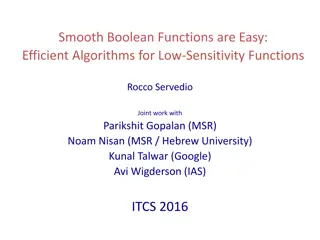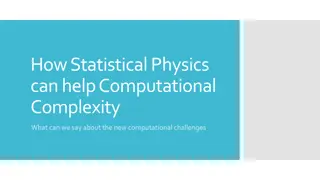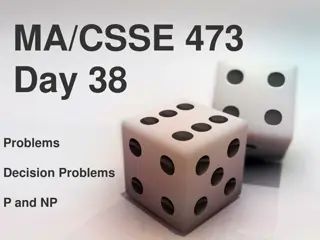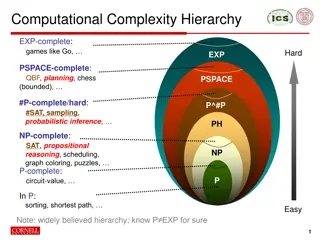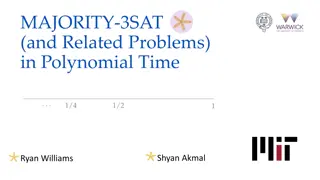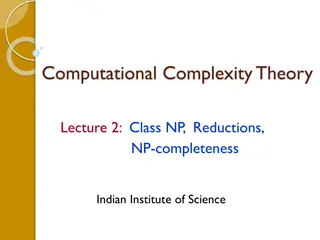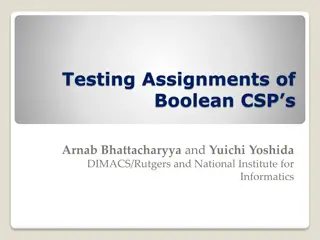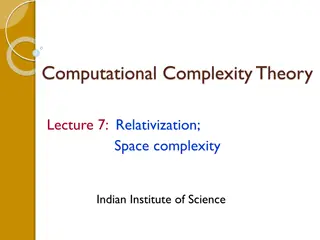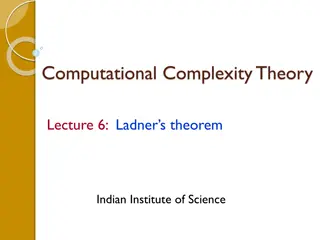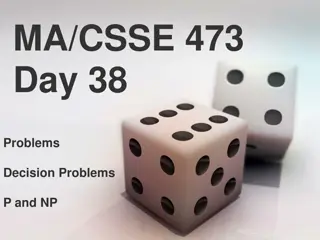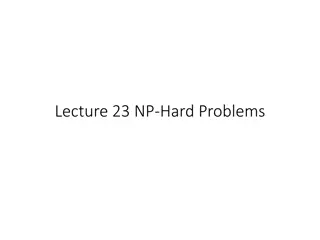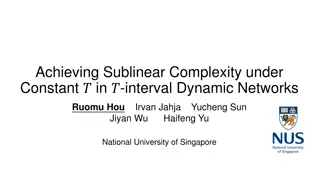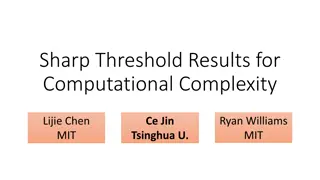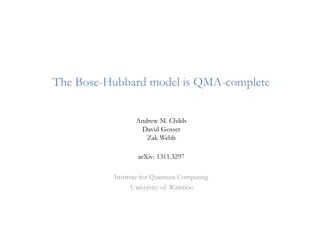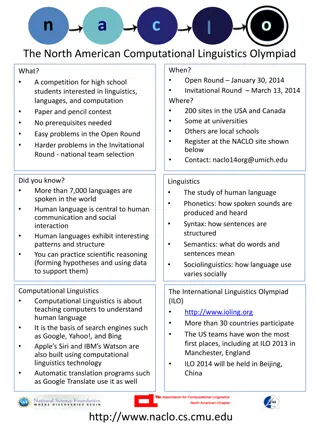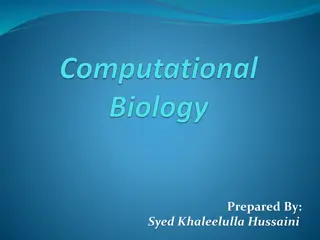Computational Complexity and NP-Complete Problems
In today's discussion, we delved into computational complexity and the challenges faced in finding efficient algorithms for various problems. We explored how some problems defy easy categorization and resist polynomial-time solutions. The concept of NP-complete problems was also introduced, highlighting the equivalence among them and the implications of solving one on the rest. The session concluded with a humorous reference to an xkcd comic reflecting the complexities of problem-solving in computer science.
Download Presentation

Please find below an Image/Link to download the presentation.
The content on the website is provided AS IS for your information and personal use only. It may not be sold, licensed, or shared on other websites without obtaining consent from the author. Download presentation by click this link. If you encounter any issues during the download, it is possible that the publisher has removed the file from their server.
E N D
Presentation Transcript
What did we talk about last time? Bipartite matching
Two vegetarians and two cannibals are on one bank of a river They have a boat that can hold at most two people Come up with a sequence of boat loads that will convey all four people safely to the other side of the river The cannibals on any given bank cannot outnumber the vegetarians or else!
Until this point in the course, we have studied efficient algorithms Polynomial time algorithms Perhaps more important than the list of algorithms we studied were the principles behind such algorithms Are there problems for which there are no efficient algorithms? The study of computational complexity tries to rank all problems based on their difficulty
Some very hard problems have been proven to have no polynomial-time algorithms Unfortunately, a large number of important problems in optimization, AI, combinatorics, logic, and other areas have resisted categorization We have not been able to find polynomial-time algorithms for these problems But we have also failed to prove that polynomial time algorithms cannot exist
NP-completeproblems are one of the classes in this gray area All NP-complete problems are essentially equivalent because a polynomial-time algorithm for one such problem would imply a polynomial-time algorithm for all of them Thus, we can think of this set of thousands of problems as really onefundamental problem
Sometimes, very small instances or very constrained instances of NP-complete problems are solvable Otherwise, we believe that NP-complete problems are computationally infeasible to solve, even though we can't prove it Why look for an efficient algorithm for a problem when no one can find an efficient one for all these famous problems?
How can we compare the hardness of problems? How are we able to say that NP-complete problems are all the same level of hardness? We want a formal way to describe that problem X is at least as hard as problem Y The tool we use to argue that X is at least as hard as Y is called a reduction
We imagine that we have a black box that can solve problem X instantly Can any instance of problem Y be solved by doing polynomial work to format the input for Y into input for X followed by a polynomial number of calls to the black box that solves X? If the answer is yes, we write Y PX and say that Y is polynomial-time reducible to X
Imagine that there is a polynomial-time algorithm to solve X We can solve Y with a polynomial prep time plus polynomial calls to X That means that Y can be solved with polynomial work plus polynomial work times polynomial work Thus, Y can also be solved in polynomial time Formally: Suppose Y PX. If X can be solved in polynomial time, then Y can be solved in polynomial time.
We didn't really study logic in this class Since we assumed you got everything you needed in MATH 1230 and COMP 2230 If you have an implication p q that is true, its contrapositive ~q ~p is also true Implication: Suppose Y PX. If X can be solved in polynomial time, then Y can be solved in polynomial time. Contrapositive: Suppose Y PX. If Y cannot be solved in polynomial time, then X cannot be solved in polynomial time.
Reductions are not one tool in our arsenal They're pretty much our only tool for comparing the difficulty of problems If you can solve a problem with a polynomial-time algorithm, you know it's polynomial For NP-complete problems (and even some higher classes), we have no way of being sure All we can do is say that one problem is at least as hard as another
Recall the independent set graph problem Given an undirected graph, find the largest collection of nodes that are not connected to each other Practical application: Nodes represent friends of yours An edge between those two nodes means they hate each other What's the largest group of friends you could invite to a party if you don't want any to hate each other?
A G B H F E C D
Independent set is an NP-complete problem We don't know a polynomial-time algorithm for it, but we don't know how to prove that there isn't one We just stated the optimization version of independent set: Find the largest independent set But there is also a decision version: Given a graph G and a number k, does G contain an independent set of size at least k?
Optimization problems feel more natural to us We want to know what the largest independent set is However, decision problems are usually used for problem reductions Why? The output is simpler. If you can efficiently solve the decision version, you can get a lot of information about the optimization version Use a binary search on k to find the size of the largest independent set Many people believe the fundamental computational hardness of a decision version is roughly the same as the optimization version, for most problems
The vertex cover problem is another graph problem: Given a graph G = (V, E), we say that a set of nodes S V is a vertex cover if every edge e E has at least one end in S In other words, find a set of vertices such that all edges touch at least one It's easy to find a big vertex cover: all vertices It's hard to find a small one Decision version: Given a graph G and a number k, does G contain a vertex cover at size at most k?
A G B H F E C D
Claim: Let G = (V,E) be a graph. S is an independent set if and only if its complement V S is a vertex cover. Proof: Suppose that S is an independent set. Consider an edge e = (u,v). Since S is independent, it cannot be the case that both u and v are in S. Thus, one of them must be in V S. It must be the case that every edge has at least one end in V S, so V S is a vertex cover.
Suppose that VS is a vertex cover. Consider any two nodes u and v in S. If they were joined by edge e, then neither end of e would lie in V S, contradicting the assumption that V S is a vertex cover. Thus, it must be the case that no two nodes in S are joined by an edge, so S must be an independent set.
Proof: If we have a black box to solve vertex cover, we can decide whether G has an independent set of size at least k by asking the black box whether G has a vertex cover of size at most n k.
Proof: If we have a black box to solve independent set, we can decide whether G has a vertex cover of size at most k by asking the black box whether G has an independent set of size at least n k.
We don't have an efficient algorithm for either independent set or vertex cover Even so, we know that they are both approximately as hard as each other These two problems are so closely related that it seems like this kind of reduction might not be generally applicable However, the entire class of NP-complete problems are all reducible to each other, so it's a pretty general technique
Independent set is a packing problem We want to pack in as many things as possible, subject to constraints Vertex cover is a covering problem We want to cover everything (edges, in this case) with the smallest number of things (vertices in this case) There are many NP-complete problems that fall into categories of packing and covering problems
Given: Set U of n elements Collection of sets S1, S2, , Sm of subsets of U A number k Is there a collection of at most k subsets whose union is equal to all of U?
S6 S1 S3 S4 S5 S2 S7
Proof: Suppose we have a black box that can solve set cover. Consider an instance of vertex cover on graph G = (V, E) with number k. We want to cover all the edges in E, so we create a set cover problem in which the universe set U is E. Each vertex in V covers some set of edges, so for every vertex i V, we add a set Si U where the elements of Si are all the edges incident on i.
We claim that U can be covered with at most k of the sets S1, S2, , Sn if and only if G has a vertex cover of size at most k. If ??1,??2, ??? are l k sets that cover U, then every edge in G is incident to one of the vertices i1, i2, , il. Thus, the set {i1,i2, ,il} is a vertex cover in G of size l k. Conversely, if {i1, i2, , il} is a vertex cover in G of size l k, then the sets ??1,??2, ??? cover U. For any vertex cover problem, we make an instance of set cover as described, pass it to our black box, and answer yes if and only if the black box answers yes.
Reductions via gadgets Certificates and the definition of NP
Finish Homework 5 Due tonight by midnight! Read 8.2 and 8.3 Study for Exam 3 Monday after next!


